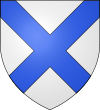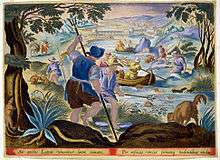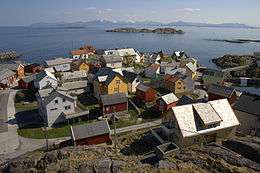Marsaxlokk
| Marsaxlokk Ix-Xatt | |||
|---|---|---|---|
| Local council | |||
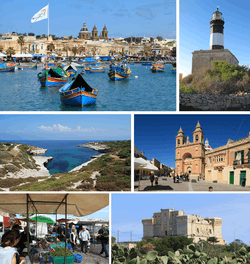 From top: Harbour, Delimara Lighthouse, Delimara coastline, Parish Church, street market, Fort San Lucian | |||
| |||
| Motto(s): Portus Herculis | |||
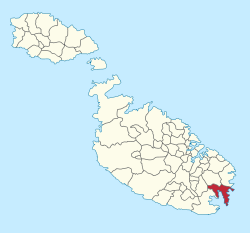 | |||
| Coordinates: 35°50′30″N 14°32′41″E / 35.84167°N 14.54472°ECoordinates: 35°50′30″N 14°32′41″E / 35.84167°N 14.54472°E | |||
| Country |
| ||
| Region | South Eastern Region | ||
| District | South Eastern District | ||
| Borders | Birżebbuġa, Għaxaq, Marsaskala, Żejtun | ||
| Government | |||
| • Mayor | Horace Gauci (PL) | ||
| Area | |||
| • Total | 4.7 km2 (1.8 sq mi) | ||
| Population (March 2014) | |||
| • Total | 3,534 | ||
| • Density | 750/km2 (1,900/sq mi) | ||
| Demonym(s) | Xlukkajr (m), Xlukkajra (f), Xlukkajri (pl) | ||
| Time zone | UTC+1 (CET) | ||
| • Summer (DST) | UTC+2 (CEST) | ||
| Postal code | MXK | ||
| Dialing code | 356 | ||
| ISO 3166 code | MT-28 | ||
| Patron saint | Our Lady of Pompeii | ||
| Day of festa | 5th Sunday in July or 1st Sunday in August | ||
| Website | Official website | ||
.jpg)
Marsaxlokk (Maltese pronunciation: [marsaʃˈlɔk]) is a traditional fishing village in the South Eastern Region of Malta, with a population of 3,534 as of March 2014.[1] The village’s name comes from marsa, which means port and xlokk, which is the local name for south-east. The word is related to the name for the dry sirocco wind that blows from the Sahara, comparable to the equivalent Catalan word, xaloc. The village is known for the Marsaxlokk Market, a large market which takes place around the whole village on Sundays and tourist market all days during the week. The inhabitants of the village are called the Xlukkajri and are historically fishermen.
History
Marsaxlokk is a fishing village in the southeast of Malta with a population of 3,534 in March 2014. The town’s name comes from marsa, that means "port" and xlokk, that is the name for south east. Marsaxlokk is best known for its tourism. The tourists like to visit the beach in summer. they also come to Marsaxlokk to see the temples of Juno. The area was first lived in when a temple was built in the bronze times of Maltese prehistory, sometime around 3000 to 2500 BC. Few remains from the original temple can be seen, but the scatter of megaliths over the hill suggests that there was a large complex with at least 3 temples and possibly a small town surrounding it . There is also Fort San Lucian Saint Lucian Tower was built above the shore of Marsaxlokk Bay on the way between Marsaxlokk and Birżebbuġa. According to local legends, a woman is said that she had a dream in which St. John advised her to tell the Grand Master to fortify the area around Marsaxlokk since an Ottoman attack was imminent. The woman told the parish priest, who told the bishop who in turn told Grand Master Alof de Wignacourt. The Grand Master did not give any importance to this, but that summer an attack really happened. Therefore, Wignacourt ordered the construction of St Lucian Tower, which was eventually built between 1610 and 1611.[1] The cost of construction was 11,745 scudi, 2 tari and 6 scudi. The tower was named after a church in France in which Wignacourt had been baptized.[2] right now Fort San Lucian is being used to save sea creatures like turtles. They also take interest in seeing the towns local sanctuary of our lady of Pompei. The parish of Marsaxlokk was established when fishermen started to build houses near the sea coast in order to save time on travelling. Thus at the end of the 19th century it was decided to build a church that would minister to the spiritual needs of the fishermen and their families. Prior to becoming a parish, Marsaxlokk was part of the parish of Żejtun. The construction of the church started in 1890.[1] It was built as a fulfilment of a promise made by Marquess Rosalia Apap Viani Testaferrata after she was saved from a violent storm at sea. The church was originally built in a rectangular form with the designs attributed to Dun Ġużepp Diacono.[2] Marsaxlokk became an independent parish in 1897. The feast of our lady is held on the last Sunday of July. It includes a procession with the statue, food stands and a firework display. Tourists also can take boat trips from marsaxlokk to birzebbugia for tourists to also visit birzebbugia . Marsaxlokk also famous for te national boats which are the luzzu and the kajjik. They serve the fisherman on fishing near the sore and for fishing away from the sore they another type of boat . Like every city it also has its downfalls. The power-station pollutes most of the air so the inhabitants dont have that much fresh air to breath.
Importance of fishing
Most of Malta's fish supplies are caught by fishermen coming from this port as about 70% of the Maltese fishing fleet is based there.[2] Swordfish, tuna, and the popular 'lampuki' are caught in abundance between spring and late autumn. On weekdays, the catch is taken to the fish-market in Valletta, but on Sundays, fish is retailed by fishermen in the open on the quay.
Fish restaurants have opened to meet the ever-increasing demand. The tourist influx to Marsaxlokk has also attracted many hawkers and souvenir vendors, which are known to have been the first to have contributed for having such a great local tourist industry.

Zones in Marsaxlokk
- Delimara
- Ħal Ġinwi
- Il-Ballut
- Il-Fossa
- Il-Magħluq
- Il-Wilġa
- Kavallerizza
- Marnisi
- Marsaxlokk Bay
- Il-Ponta l-Kbira
- San Duminku
- St. Peter's Pool
- Il-Ponta Tal-Qrejten
- Tal-Wiċċ
- Tas-Silġ
- Torri San Luċjan
- Xorb l-Għaġin
- Port Ruman
Sports
Marsaxlokk F.C., formed in 1949, is the village's main football team. It plays in the Maltese 2nd Division, with home games taking place at the Ta' Qali Stadium. Marsaxlokk also has a water polo team, which dates to 1952.
References
- ↑ "Estimated Population by Locality 31st March, 2014". Government of Malta. 16 May 2014. Archived from the original on 21 June 2015.
- ↑ https://www.lonelyplanet.com/malta/marsaxlokk
- Grech, Joseph Marsaxlokk: 100 sena parroċċa
- Abela, Joe Dun Marsaxlokk
External links
| Wikimedia Commons has media related to Marsaxlokk. |

